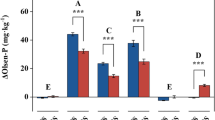Abstract.
Accumulated soil P in agricultural soils is a major source of soluble and particulate forms of P entering water resources and degrading water quality. However, few research sites are currently available to evaluate the long-term effects of different cropping systems and fertility practices on soil inorganic and organic P accumulation. The objectives of this study were: (1) to compare the forms and quantity of different inorganic and organic soil P fractions in plots on Sanborn Field, which has been cultivated for 111 years; and (2) to assess the use of standard soil test P extractants for determining changes in soil P dynamics over time. A modified sequential P extraction procedure was used to separate labile and stable inorganic and organic P pools from surface soils collected on Sanborn Field in 1915, 1938, 1962, and 1999 from plots in continuous corn, continuous wheat, continuous timothy, and a corn–wheat–clover rotation amended with either manufactured fertilizers, horse or dairy manure or receiving no fertilization since 1888. Additional samples were collected from a native grass prairie site of a similar soil series to estimate soil characteristics at Sanborn Field before initial cultivation in 1888. Observed accumulation of Bray-1 P among fertilizer and manure treatments was attributed to over-application of P due to unrealistically high yield goals for each cropping system. Long-term cultivation of Sanborn Field increased soil bulk density and lowered soil pH and total organic C compared with native prairie. Fertilization either by addition of manufactured fertilizer or manure significantly increased inorganic resin-P and inorganic NaOH-extractable P. Applications of animal manure also significantly increased most organic P fractions compared with the unfertilized treatment. The native prairie had a larger proportion of total P in organic forms compared with cultivated plots, especially in organic NaOH-extractable P, but no significant decreases in either residual or total P were observed due to cultivation. This study confirms that soil P availability in cropping systems that are amended with predominantly organic P amendments may differ from conventional cropping systems relying on manufactured P fertilizers. However, no direct evidence was found to support the hypothesis that any individual inorganic or organic soil P fraction has a better relationship than conventional soil test P extractants with plant P uptake under contrasting organic and conventional fertility practices.
Similar content being viewed by others
Author information
Authors and Affiliations
Additional information
Electronic Publication
Rights and permissions
About this article
Cite this article
Motavalli, .P., Miles, .R. Soil phosphorus fractions after 111 years of animal manure and fertilizer applications. Biol Fertil Soils 36, 35–42 (2002). https://doi.org/10.1007/s00374-002-0500-6
Received:
Accepted:
Issue Date:
DOI: https://doi.org/10.1007/s00374-002-0500-6




